
MHA2MLA
Towards Economical Inference: Enabling DeepSeek's Multi-Head Latent Attention in Any Transformer-based LLMs
Stars: 145

This repository contains the code for the paper 'Towards Economical Inference: Enabling DeepSeek's Multi-Head Latent Attention in Any Transformer-based LLMs'. It provides tools for fine-tuning and evaluating Llama models, converting models between different frameworks, processing datasets, and performing specific model training tasks like Partial-RoPE Fine-Tuning and Multiple-Head Latent Attention Fine-Tuning. The repository also includes commands for model evaluation using Lighteval and LongBench, along with necessary environment setup instructions.
README:
This repo contains the code for the paper "Towards Economical Inference: Enabling DeepSeek's Multi-Head Latent Attention in Any Transformer-based LLMs".
- [2025.03.12] Released the inference code implemented using PyTorch (support for FlashMLA inference requires additional development time).
- [2025.03.04] The four MLA checkpoints ($d_{kv}$=8/16/32/128) derived from
SmolLM-135M/360M/1B7are publicly available. - [2025.03.03] The four MLA checkpoints ($d_{kv}$=16/32/64/256) derived from
Llama-2-7Bare publicly available. - [2025.02.21] The paper of MHA2MLA is publicly available: https://arxiv.org/abs/2502.14837
- [2025.02.19] Released the first version of the MHA2MLA code, providing usage code for Llama fine-tuning and evaluating.
- [ ]
Provide the code for incorporating the projection matrix and inference. - [ ] Thanks to DeepSeek for open-sourcing the FlashMLA inference framework. It’s theoretically possible to save more GPU memory usage using this framework. Let’s see how economical MHA2MLA + FlashMLA (+ KV quanto) can be!
- [x] Release the code of MHA2MLA based on HuggingFace
Transformers
- SmolLM: https://huggingface.co/blog/smollm
- Llama-2-7b-hf: https://huggingface.co/meta-llama/Llama-2-7b-hf
First download the datasets.
- smollm-corpus(fineweb-edu-dedup, cosmopedia-v2, python-edu): https://huggingface.co/datasets/HuggingFaceTB/smollm-corpus
- open-web-math: https://huggingface.co/datasets/open-web-math/open-web-math
- stackoverflow: https://huggingface.co/datasets/bigcode/stackoverflow-clean
Secondly, process the datasets according to https://github.com/huggingface/nanotron/blob/main/docs/nanoset.md.
Install pytorch and other packages.
conda create -n mla-ft python=3.11
pip install torch==2.4.0 torchvision==0.19.0
pip install -r requirements.txtThe research presented in our paper was conducted using nanotron framework. Since there are differences between
transformersandnanotron, hyperparameter search might be necessary. For exact reproduction of the paper's results, we recommend using nanotron for fine tuneing which refer to Our README for MHA2MLA using nanotron.
First, prepare three configuration files:
- A general configuration file referencing 135M_4GPU.yaml
- A partial-RoPE configuration file referencing rope_v4_topk4.yaml
- A SVD configuration file referencing svd_method7_rank8.yaml
The available strategies for each method are listed below:
| Partial-RoPE version | Strategy |
|---|---|
| 0 | full-RoPE |
| 1 | $\mathcal{S}_{\text{high}}$ |
| 2 | $\mathcal{S}_{\text{uniform}}$ |
| 4 | $\mathcal{S}_{\text{2-norm}}$ |
| 5 | $\mathcal{S}_{\text{low}}$ |
| SVD version | Strategy |
|---|---|
| 2 | $SVD_{split}$ |
| 7 | $SVD_{joint}$ |
Then, use the following command for MLA fine-tuning:
torchrun --nproc_per_node 4 \
../src/mha2mla/run_train.py \
--config_file ../configs_hf/rope/135M_4GPU.yaml \
--partial_rope_config ../configs_hf/rope/rope_v4_topk4.yaml \
--svd_config ../configs_hf/rope/svd_method7_rank8.yamlIf you want to use the partial-RoPE version 4, you should get the
qk_tensorfirst. Using the following command, you can get theqk_tensor:torchrun --nproc_per_node 1 \ ../src/mha2mla/2_norm.py \ --config_file ../configs_hf/rope/135M_4GPU.yaml \ --output_dir ./qk_tensor_hf_test.pth \ --sample_size 1024
For the MLA evaluation, you can use the following command:
accelerate launch --multi_gpu --num_processes=4 \
../src/mha2mla/eval.py --is_mla \
accelerate \
--model_args "pretrained=${model_name_or_path},revision=main,dtype=bfloat16,max_length=2048" \
--override_batch_size 48 \
--custom_tasks "../src/mha2mla/tasks.py" \
--tasks "../src/mha2mla/smollm1_base.txt" \
--output_dir "../eval_results/"If you want to evaluate the
partial_ropeckpt withoutlow rank approx, you should change--is_mlato--is_partial_rope.
For the baseline evaluation, you can use the following command:
torchrun --nproc_per_node=4 \
../src/mha2mla/longbench.py \
--model_path ${model_name_or_path} \
--tokenizer_path ${model_name_or_path} \
--longbench True \
--lb_max_tokens 2048 \
--lb_batch_size 16 \
--output_dir /longbench/bf16 \
--dtype "bfloat16"For the MLA model, you should add the parameter --is_mla to the command.
If you want to use the quantized KV cache, you can use the following command:
torchrun --nproc_per_node=4 \
../src/mha2mla/longbench.py \
--model_path ${model_name_or_path} \
--tokenizer_path ${model_name_or_path} \
--longbench True \
--lb_max_tokens 2048 \
--lb_batch_size 16 \
--output_dir /longbench/${model_name_or_path}_hqq_int4 \
--dtype "bfloat16" \
--cache_implementation "quantized" \
--backend "HQQ" \
--nbits 4 \
--residual_length 128 \- Step 1: Download the monkey patch file.
wget https://raw.githubusercontent.com/JT-Ushio/MHA2MLA/refs/heads/main/src/mha2mla/monkey_patch.py- Step 2(Option): For MHA2MLA models using Partial-RoPE 2-nrom method, Download the qk_2-norm file.
Take
qk_tensor_1.7B.pthas an example:
wget https://github.com/JT-Ushio/MHA2MLA/raw/refs/heads/main/utils/qk_tensor_1.7B.pth- Step 3: Download the MHA2MLA models and run inference.
Take
fnlp/SmolLM-1B7-MLA-d_kv_16as an example:
import torch
from transformers import AutoConfig, AutoTokenizer, LlamaForCausalLM
from monkey_patch import infer_monkey_patch
model_name = "fnlp/SmolLM-1B7-MLA-d_kv_16"
# Monkey Patch: MHA -> MLA
config = AutoConfig.from_pretrained(model_name)
if "RoPE" in config:
config.RoPE["qk_tensor_path"] = "qk_tensor_1.7B.pth" # Configuration for Specific Models
infer_monkey_patch(config.RoPE)
tokenizer = AutoTokenizer.from_pretrained(model_name, trust_remote_code=True)
model = LlamaForCausalLM.from_pretrained(model_name, config=config, torch_dtype=torch.bfloat16).cuda()
# Generate
text = "Which American-born Sinclair won the Nobel Prize for Literature in 1930?"
inputs = tokenizer(text, return_tensors="pt").to(model.device)
generation_kwargs = {"do_sample": False, "use_cache": True, "max_new_tokens": 128}
output = model.generate(**inputs, **generation_kwargs)
print(tokenizer.decode(output[0], skip_special_tokens=True))
# - Sinclair Lewis@misc{ji2025economicalinferenceenablingdeepseeks,
title={Towards Economical Inference: Enabling DeepSeek's Multi-Head Latent Attention in Any Transformer-based LLMs},
author={Tao Ji and Bin Guo and Yuanbin Wu and Qipeng Guo and Lixing Shen and Zhan Chen and Xipeng Qiu and Qi Zhang and Tao Gui},
year={2025},
eprint={2502.14837},
archivePrefix={arXiv},
primaryClass={cs.CL},
url={https://arxiv.org/abs/2502.14837},
}
For Tasks:
Click tags to check more tools for each tasksFor Jobs:
Alternative AI tools for MHA2MLA
Similar Open Source Tools

MHA2MLA
This repository contains the code for the paper 'Towards Economical Inference: Enabling DeepSeek's Multi-Head Latent Attention in Any Transformer-based LLMs'. It provides tools for fine-tuning and evaluating Llama models, converting models between different frameworks, processing datasets, and performing specific model training tasks like Partial-RoPE Fine-Tuning and Multiple-Head Latent Attention Fine-Tuning. The repository also includes commands for model evaluation using Lighteval and LongBench, along with necessary environment setup instructions.
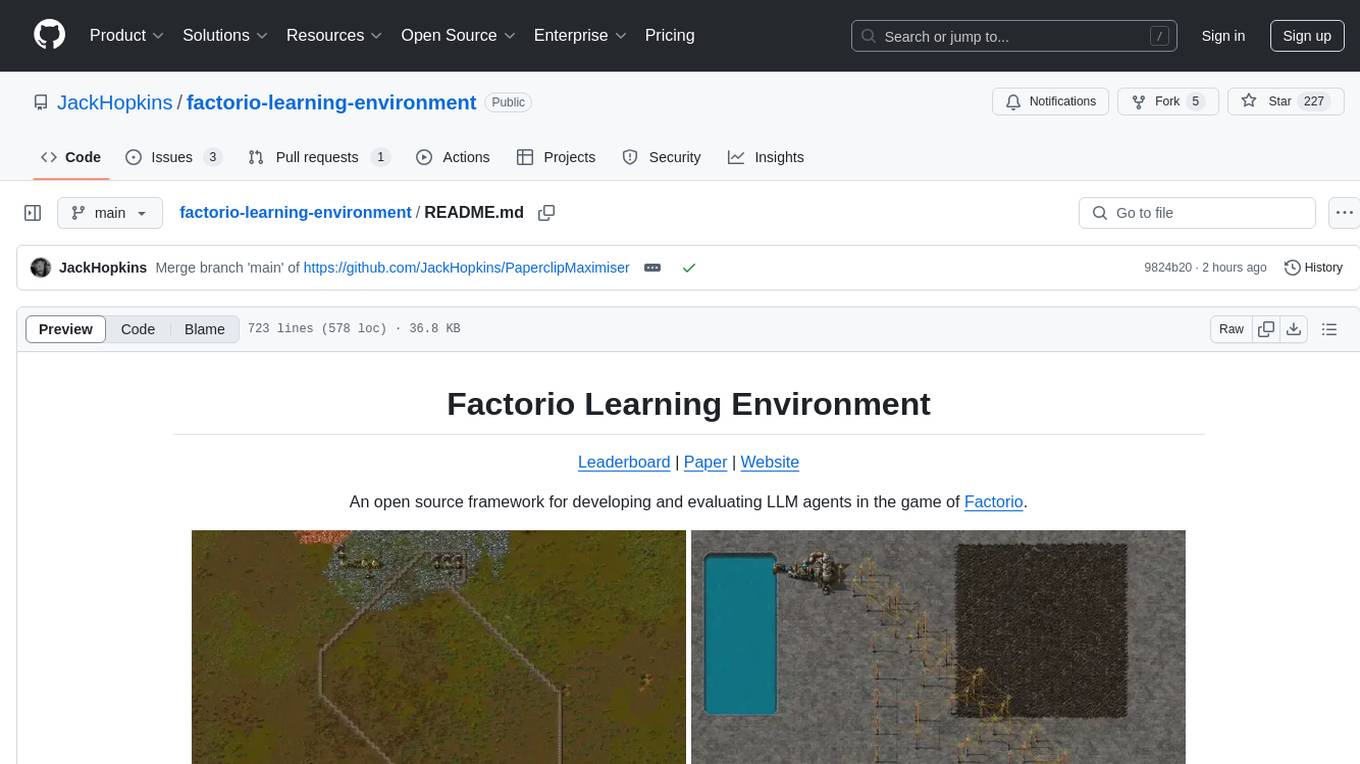
factorio-learning-environment
Factorio Learning Environment is an open source framework designed for developing and evaluating LLM agents in the game of Factorio. It provides two settings: Lab-play with structured tasks and Open-play for building large factories. Results show limitations in spatial reasoning and automation strategies. Agents interact with the environment through code synthesis, observation, action, and feedback. Tools are provided for game actions and state representation. Agents operate in episodes with observation, planning, and action execution. Tasks specify agent goals and are implemented in JSON files. The project structure includes directories for agents, environment, cluster, data, docs, eval, and more. A database is used for checkpointing agent steps. Benchmarks show performance metrics for different configurations.
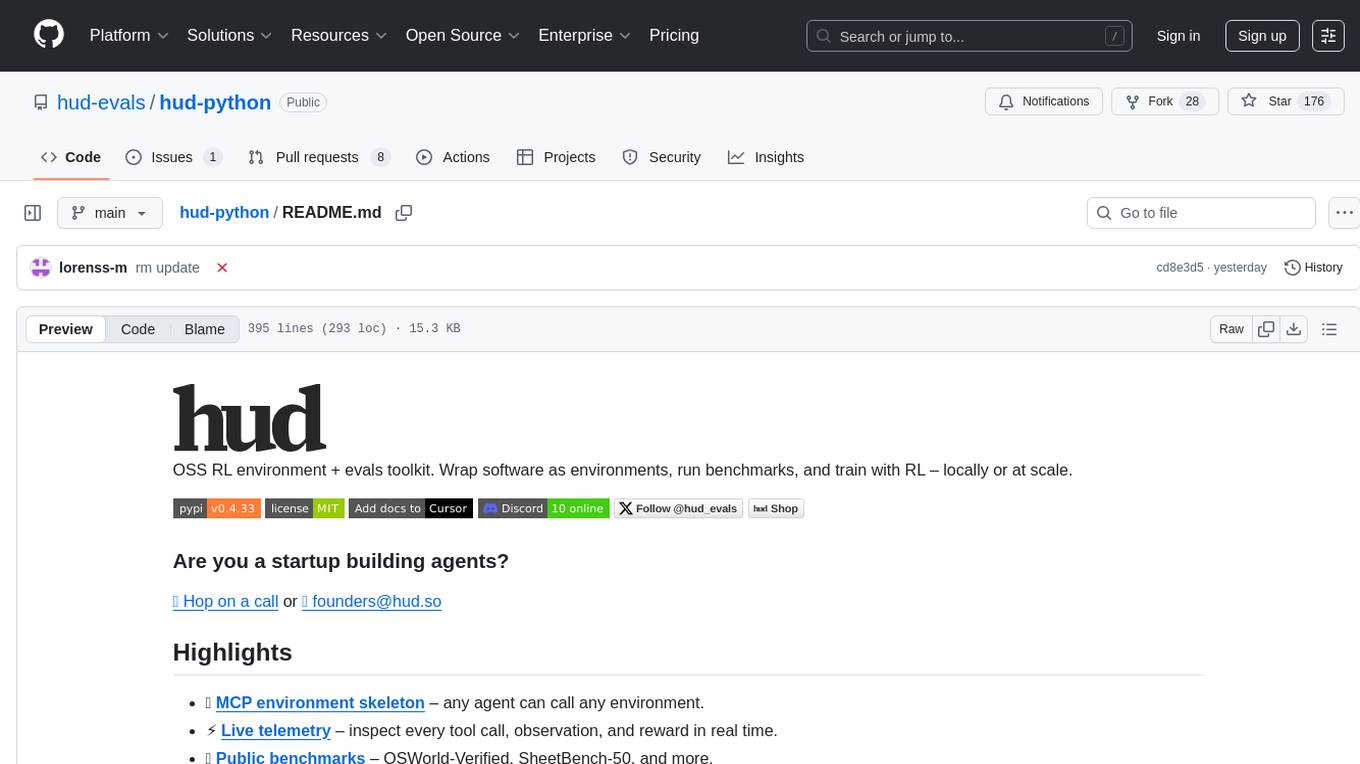
hud-python
hud-python is a Python library for creating interactive heads-up displays (HUDs) in video games. It provides a simple and flexible way to overlay information on the screen, such as player health, score, and notifications. The library is designed to be easy to use and customizable, allowing game developers to enhance the user experience by adding dynamic elements to their games. With hud-python, developers can create engaging HUDs that improve gameplay and provide important feedback to players.
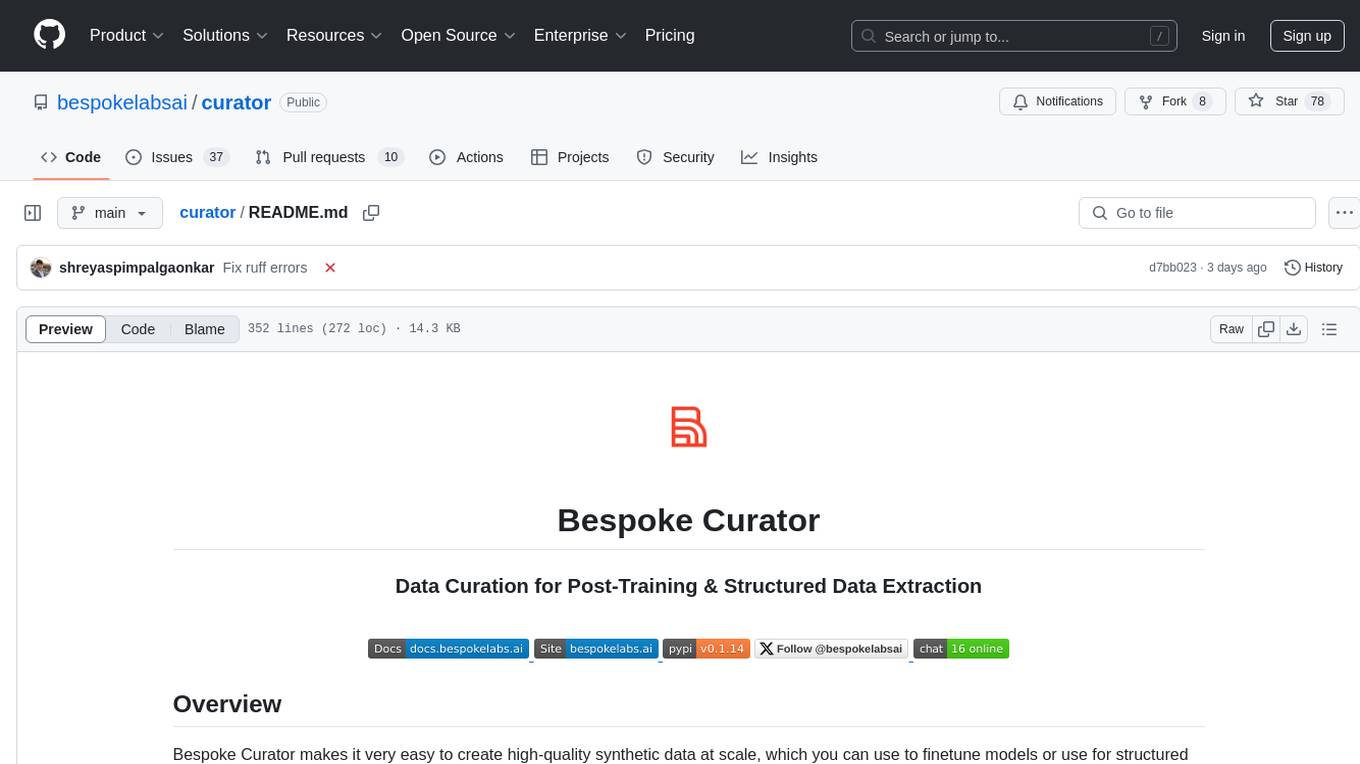
curator
Bespoke Curator is an open-source tool for data curation and structured data extraction. It provides a Python library for generating synthetic data at scale, with features like programmability, performance optimization, caching, and integration with HuggingFace Datasets. The tool includes a Curator Viewer for dataset visualization and offers a rich set of functionalities for creating and refining data generation strategies.
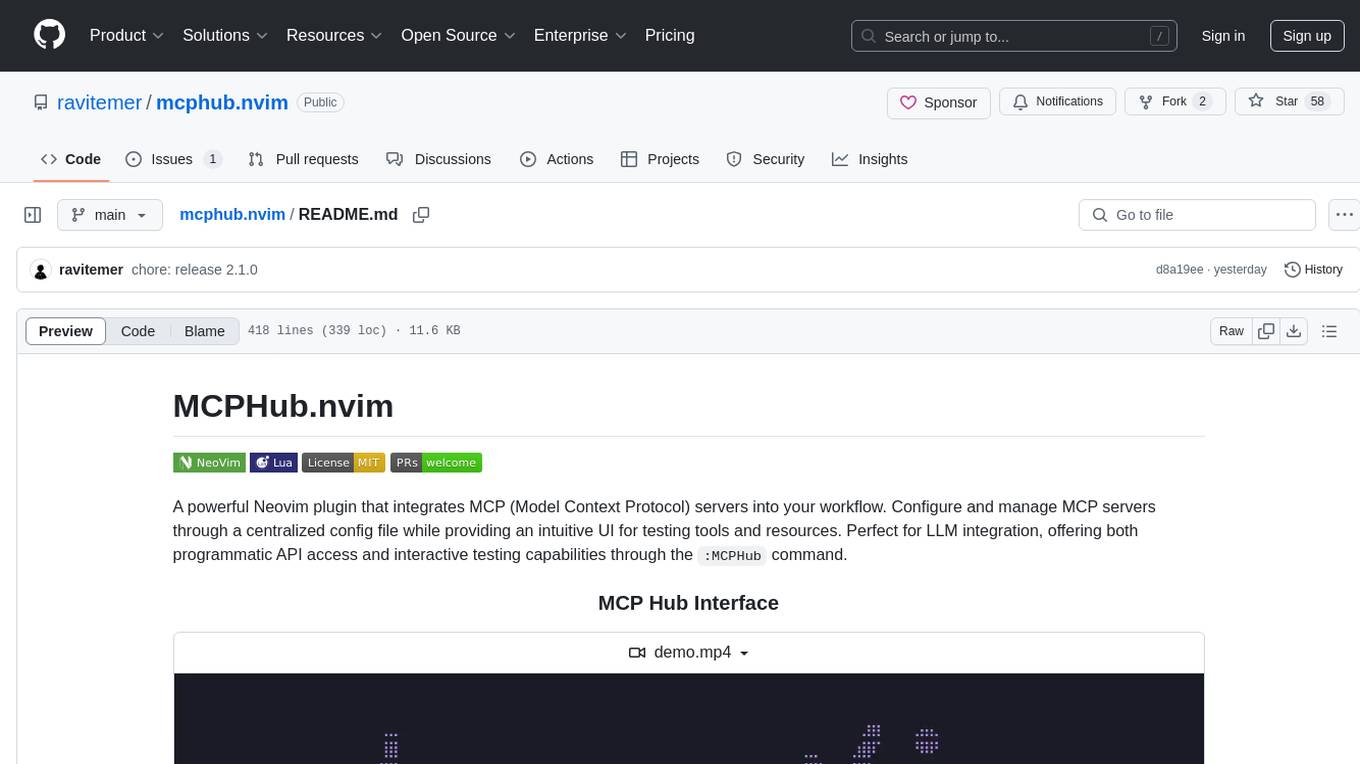
mcphub.nvim
MCPHub.nvim is a powerful Neovim plugin that integrates MCP (Model Context Protocol) servers into your workflow. It offers a centralized config file for managing servers and tools, with an intuitive UI for testing resources. Ideal for LLM integration, it provides programmatic API access and interactive testing through the `:MCPHub` command.
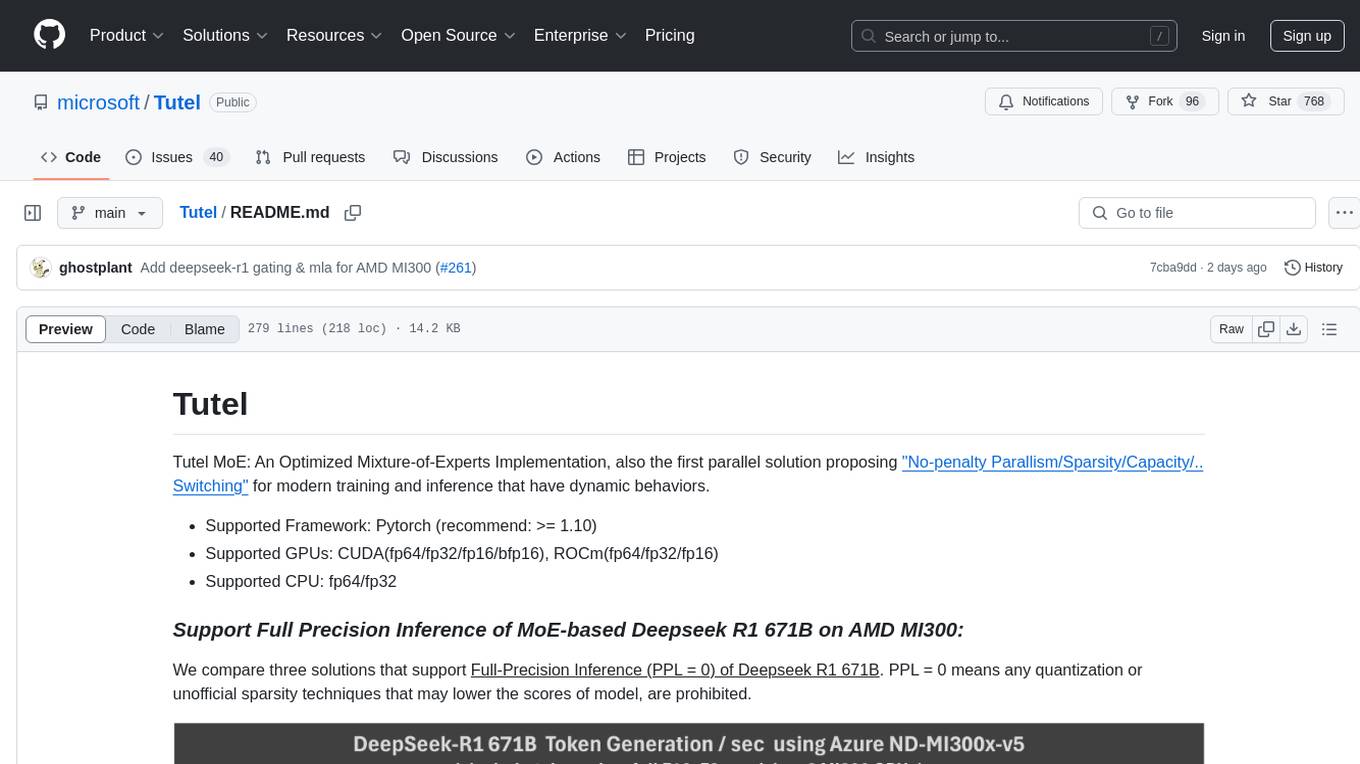
Tutel
Tutel MoE is an optimized Mixture-of-Experts implementation that offers a parallel solution with 'No-penalty Parallism/Sparsity/Capacity/Switching' for modern training and inference. It supports Pytorch framework (version >= 1.10) and various GPUs including CUDA and ROCm. The tool enables Full Precision Inference of MoE-based Deepseek R1 671B on AMD MI300. Tutel provides features like all-to-all benchmarking, tensorcore option, NCCL timeout settings, Megablocks solution, and dynamic switchable configurations. Users can run Tutel in distributed mode across multiple GPUs and machines. The tool allows for custom MoE implementations and offers detailed usage examples and reference documentation.

OSA
OSA (Open-Source-Advisor) is a tool designed to improve the quality of scientific open source projects by automating the generation of README files, documentation, CI/CD scripts, and providing advice and recommendations for repositories. It supports various LLMs accessible via API, local servers, or osa_bot hosted on ITMO servers. OSA is currently under development with features like README file generation, documentation generation, automatic implementation of changes, LLM integration, and GitHub Action Workflow generation. It requires Python 3.10 or higher and tokens for GitHub/GitLab/Gitverse and LLM API key. Users can install OSA using PyPi or build from source, and run it using CLI commands or Docker containers.
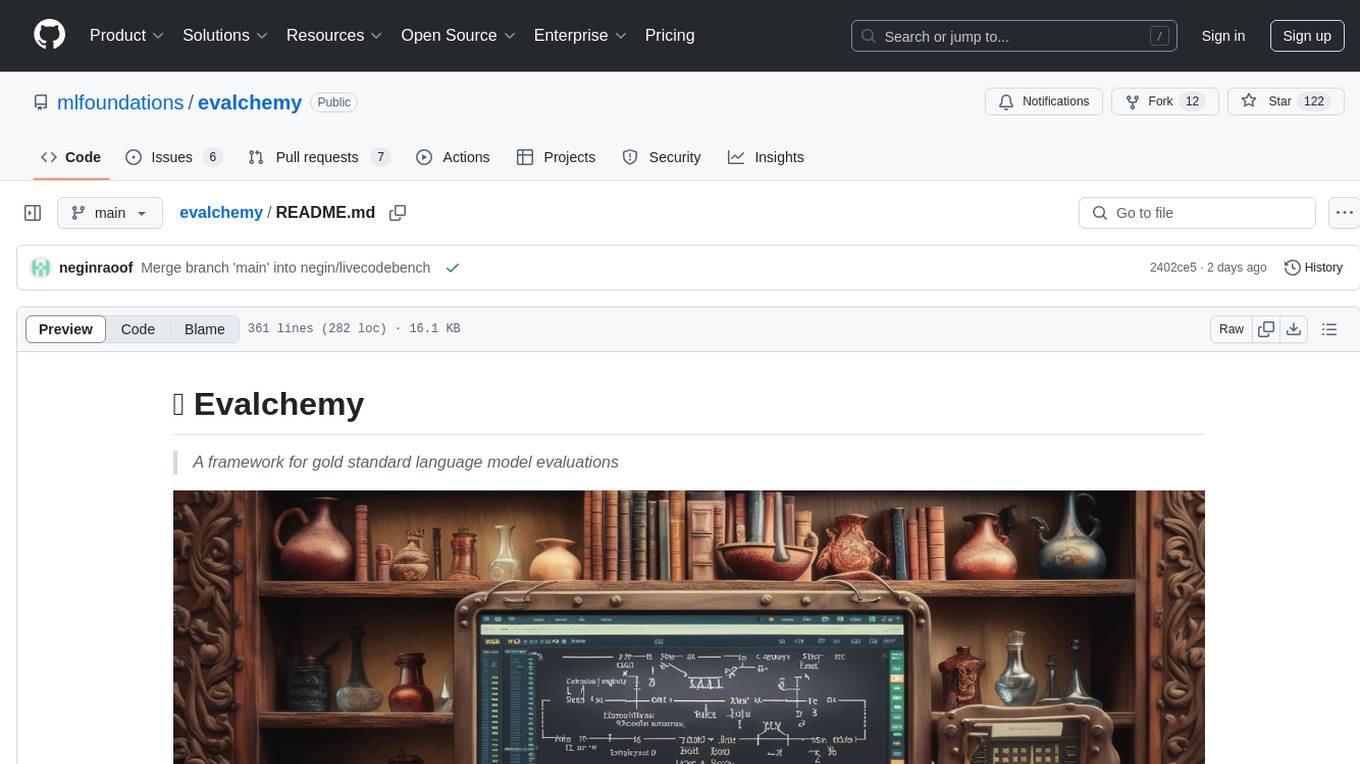
evalchemy
Evalchemy is a unified and easy-to-use toolkit for evaluating language models, focusing on post-trained models. It integrates multiple existing benchmarks such as RepoBench, AlpacaEval, and ZeroEval. Key features include unified installation, parallel evaluation, simplified usage, and results management. Users can run various benchmarks with a consistent command-line interface and track results locally or integrate with a database for systematic tracking and leaderboard submission.
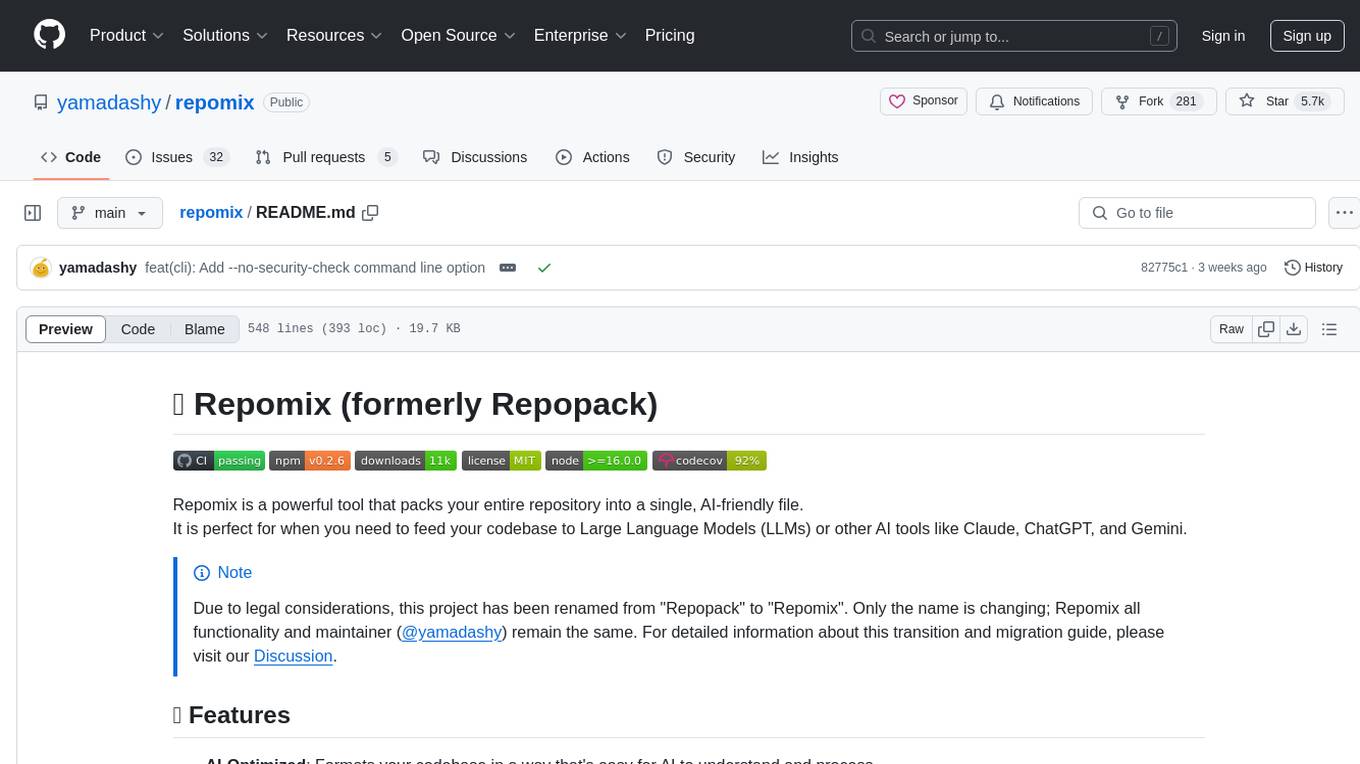
repomix
Repomix is a powerful tool that packs your entire repository into a single, AI-friendly file. It is designed to format your codebase for easy understanding by AI tools like Large Language Models (LLMs), Claude, ChatGPT, and Gemini. Repomix offers features such as AI optimization, token counting, simplicity in usage, customization options, Git awareness, and security-focused checks using Secretlint. It allows users to pack their entire repository or specific directories/files using glob patterns, and even supports processing remote Git repositories. The tool generates output in plain text, XML, or Markdown formats, with options for including/excluding files, removing comments, and performing security checks. Repomix also provides a global configuration option, custom instructions for AI context, and a security check feature to detect sensitive information in files.
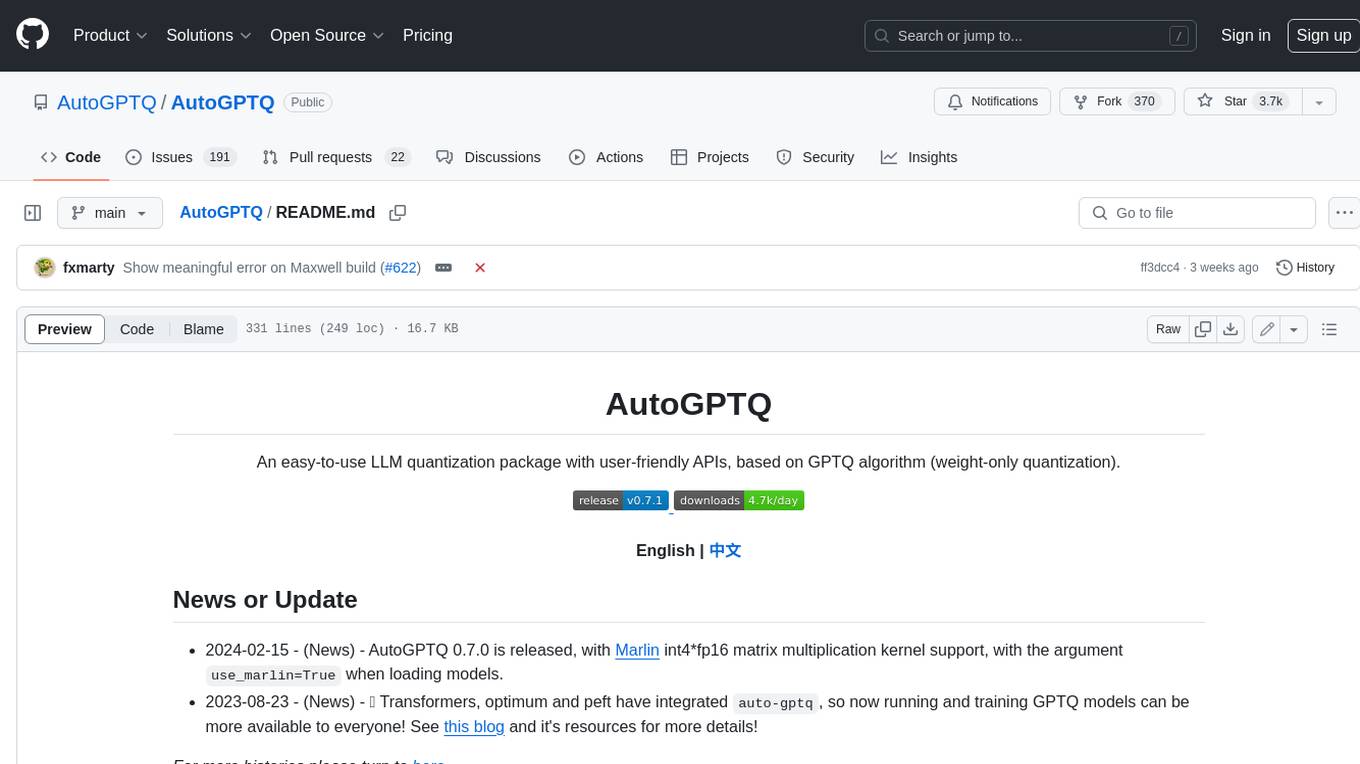
AutoGPTQ
AutoGPTQ is an easy-to-use LLM quantization package with user-friendly APIs, based on GPTQ algorithm (weight-only quantization). It provides a simple and efficient way to quantize large language models (LLMs) to reduce their size and computational cost while maintaining their performance. AutoGPTQ supports a wide range of LLM models, including GPT-2, GPT-J, OPT, and BLOOM. It also supports various evaluation tasks, such as language modeling, sequence classification, and text summarization. With AutoGPTQ, users can easily quantize their LLM models and deploy them on resource-constrained devices, such as mobile phones and embedded systems.

ax
Ax is a Typescript library that allows users to build intelligent agents inspired by agentic workflows and the Stanford DSP paper. It seamlessly integrates with multiple Large Language Models (LLMs) and VectorDBs to create RAG pipelines or collaborative agents capable of solving complex problems. The library offers advanced features such as streaming validation, multi-modal DSP, and automatic prompt tuning using optimizers. Users can easily convert documents of any format to text, perform smart chunking, embedding, and querying, and ensure output validation while streaming. Ax is production-ready, written in Typescript, and has zero dependencies.
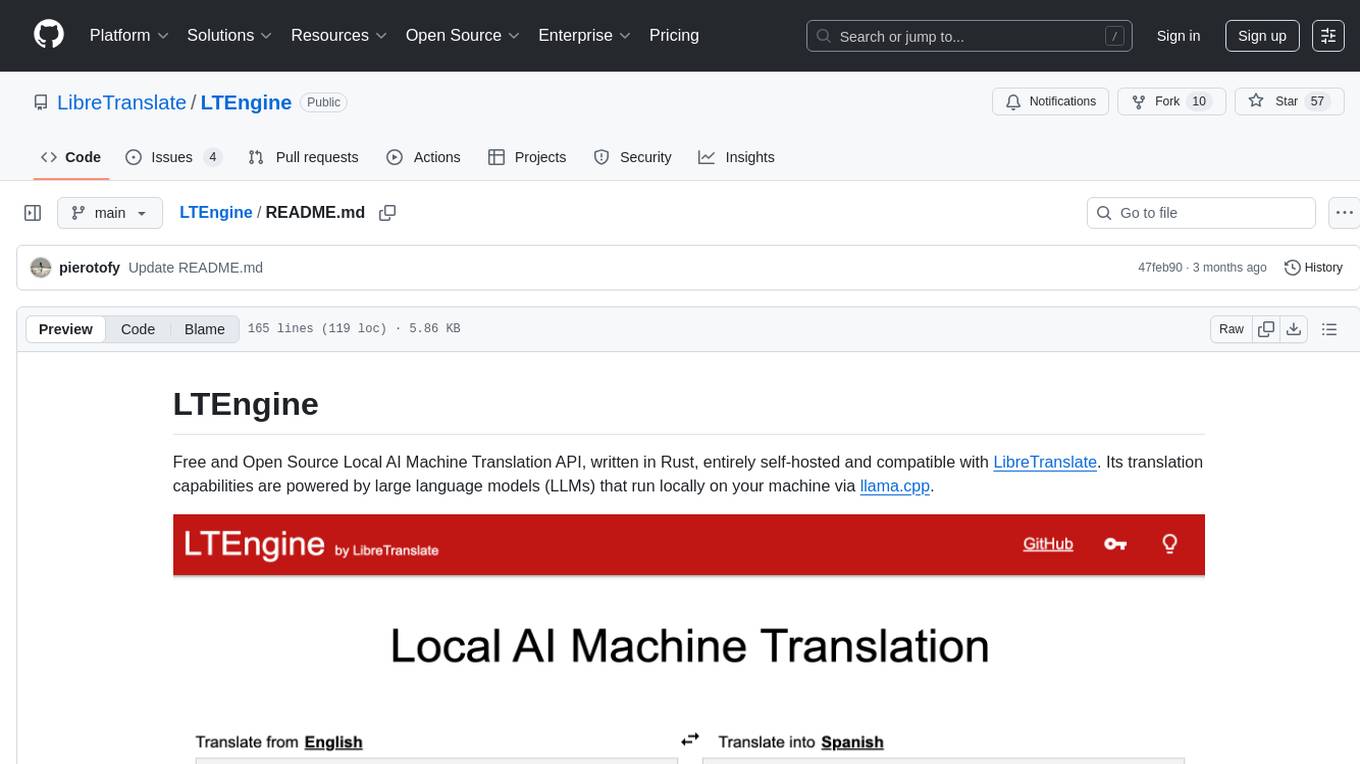
LTEngine
LTEngine is a free and open-source local AI machine translation API written in Rust. It is self-hosted and compatible with LibreTranslate. LTEngine utilizes large language models (LLMs) via llama.cpp, offering high-quality translations that rival or surpass DeepL for certain languages. It supports various accelerators like CUDA, Metal, and Vulkan, with the largest model 'gemma3-27b' fitting on a single consumer RTX 3090. LTEngine is actively developed, with a roadmap outlining future enhancements and features.
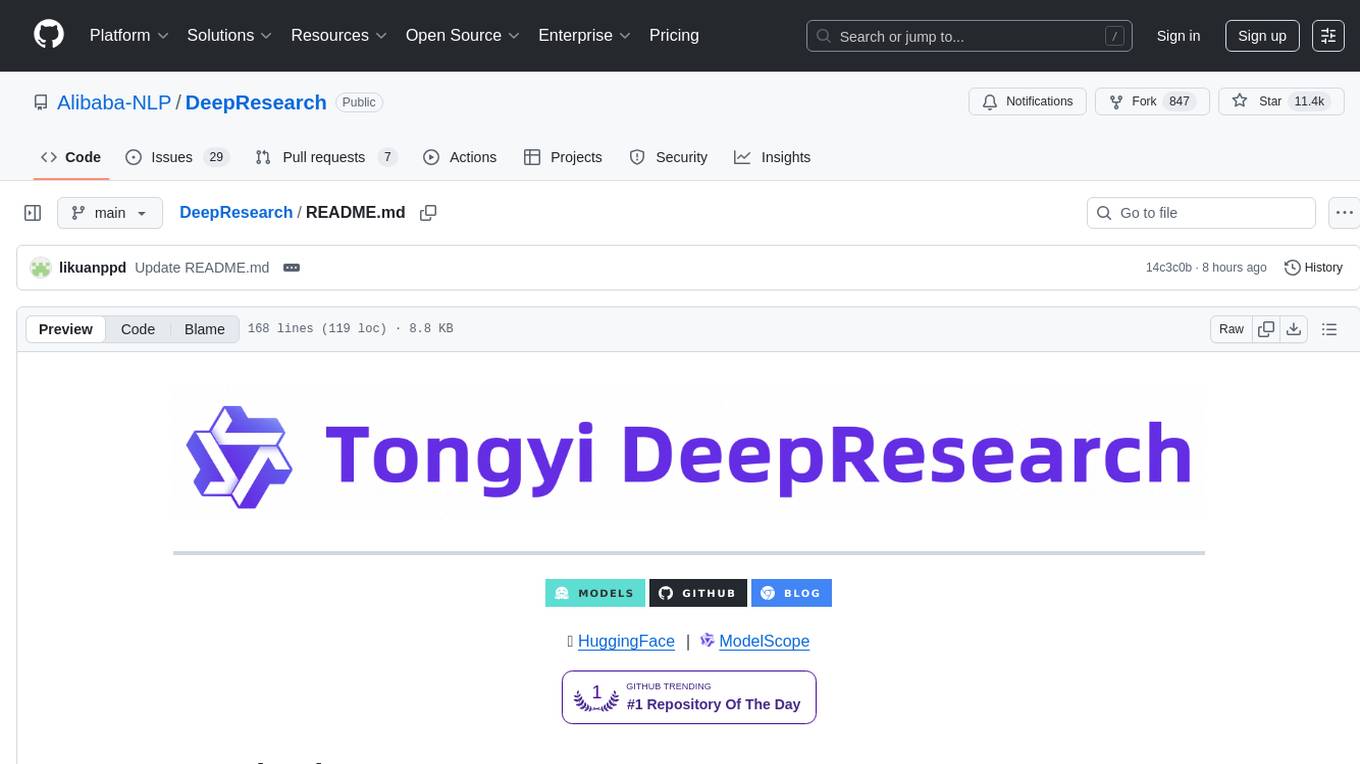
DeepResearch
Tongyi DeepResearch is an agentic large language model with 30.5 billion total parameters, designed for long-horizon, deep information-seeking tasks. It demonstrates state-of-the-art performance across various search benchmarks. The model features a fully automated synthetic data generation pipeline, large-scale continual pre-training on agentic data, end-to-end reinforcement learning, and compatibility with two inference paradigms. Users can download the model directly from HuggingFace or ModelScope. The repository also provides benchmark evaluation scripts and information on the Deep Research Agent Family.
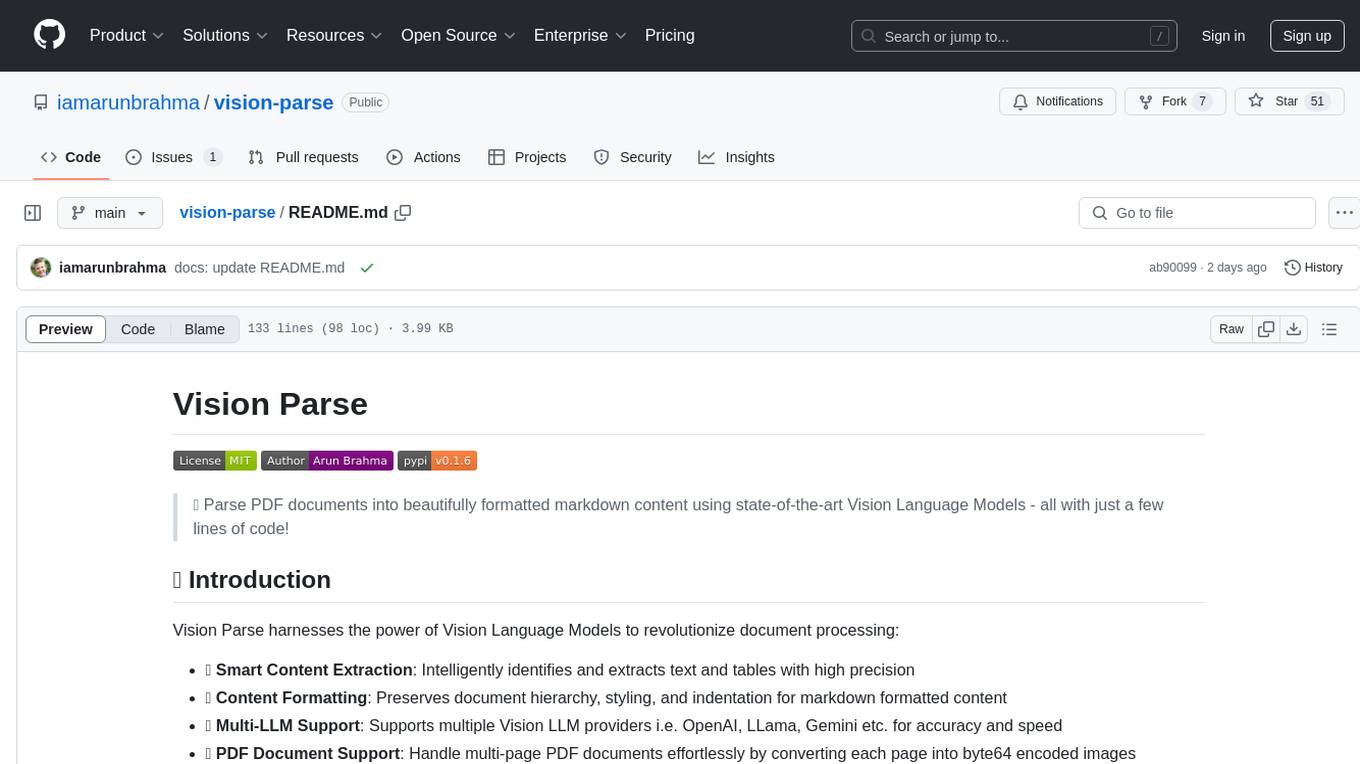
vision-parse
Vision Parse is a tool that leverages Vision Language Models to parse PDF documents into beautifully formatted markdown content. It offers smart content extraction, content formatting, multi-LLM support, PDF document support, and local model hosting using Ollama. Users can easily convert PDFs to markdown with high precision and preserve document hierarchy and styling. The tool supports multiple Vision LLM providers like OpenAI, LLama, and Gemini for accuracy and speed, making document processing efficient and effortless.

onnxruntime-server
ONNX Runtime Server is a server that provides TCP and HTTP/HTTPS REST APIs for ONNX inference. It aims to offer simple, high-performance ML inference and a good developer experience. Users can provide inference APIs for ONNX models without writing additional code by placing the models in the directory structure. Each session can choose between CPU or CUDA, analyze input/output, and provide Swagger API documentation for easy testing. Ready-to-run Docker images are available, making it convenient to deploy the server.
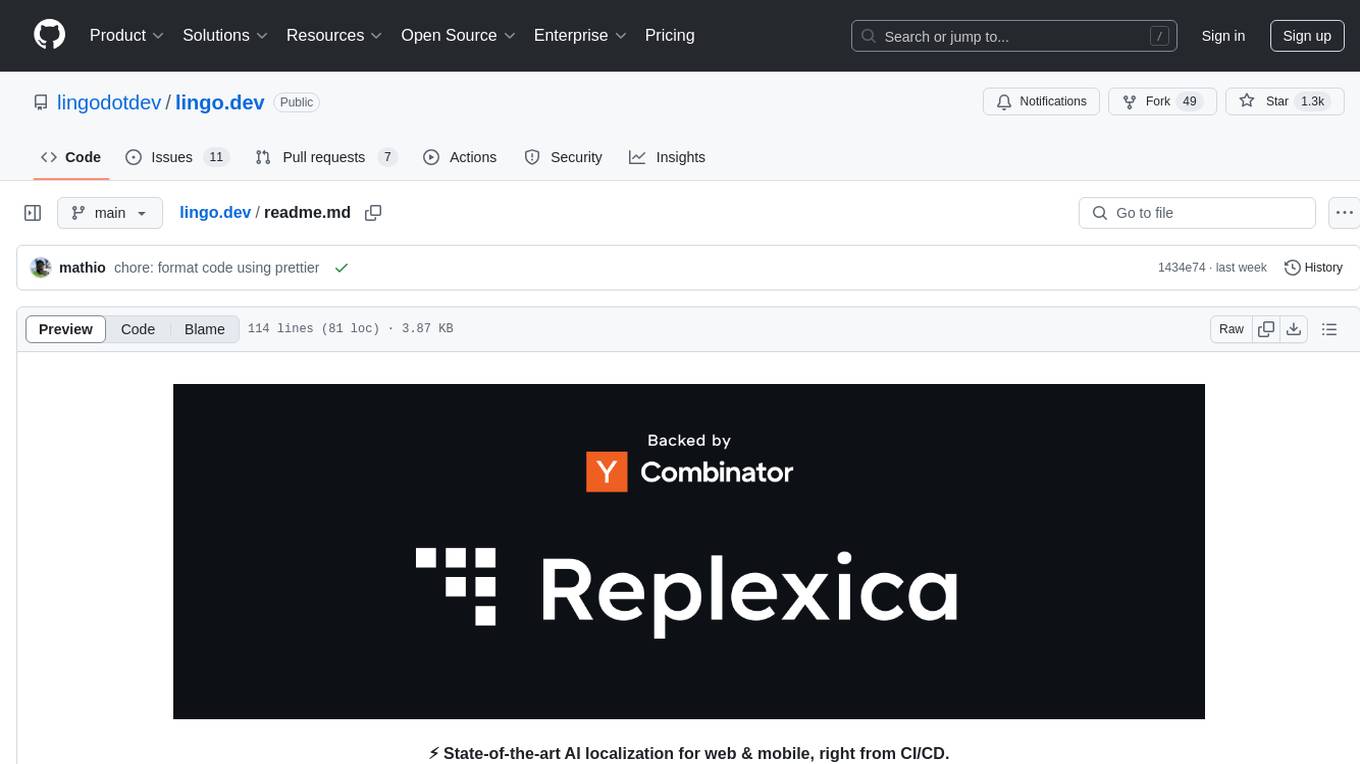
lingo.dev
Replexica AI automates software localization end-to-end, producing authentic translations instantly across 60+ languages. Teams can do localization 100x faster with state-of-the-art quality, reaching more paying customers worldwide. The tool offers a GitHub Action for CI/CD automation and supports various formats like JSON, YAML, CSV, and Markdown. With lightning-fast AI localization, auto-updates, native quality translations, developer-friendly CLI, and scalability for startups and enterprise teams, Replexica is a top choice for efficient and effective software localization.
For similar tasks
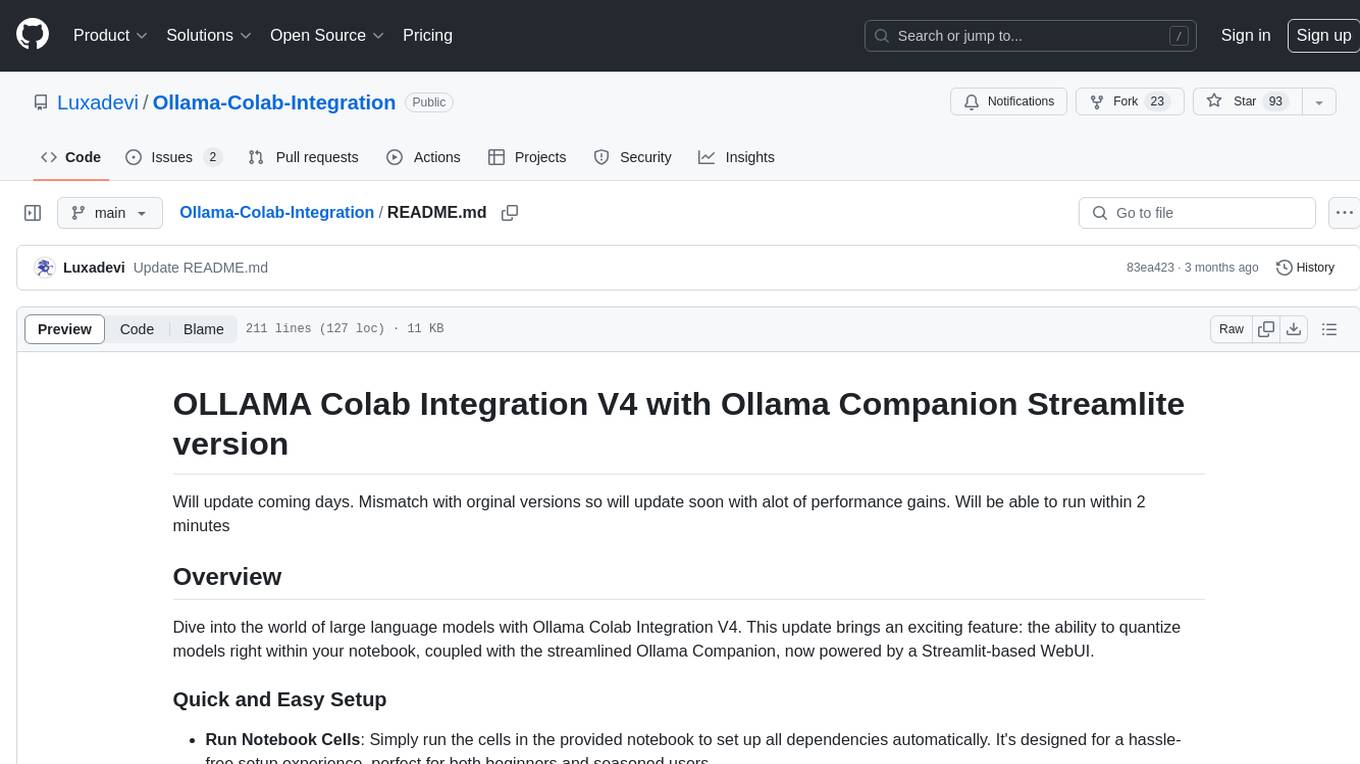
Ollama-Colab-Integration
Ollama Colab Integration V4 is a tool designed to enhance the interaction and management of large language models. It allows users to quantize models within their notebook environment, access a variety of models through a user-friendly interface, and manage public endpoints efficiently. The tool also provides features like LiteLLM proxy control, model insights, and customizable model file templating. Users can troubleshoot model loading issues, CPU fallback strategies, and manage VRAM and RAM effectively. Additionally, the tool offers functionalities for downloading model files from Hugging Face, model conversion with high precision, model quantization using Q and Kquants, and securely uploading converted models to Hugging Face.
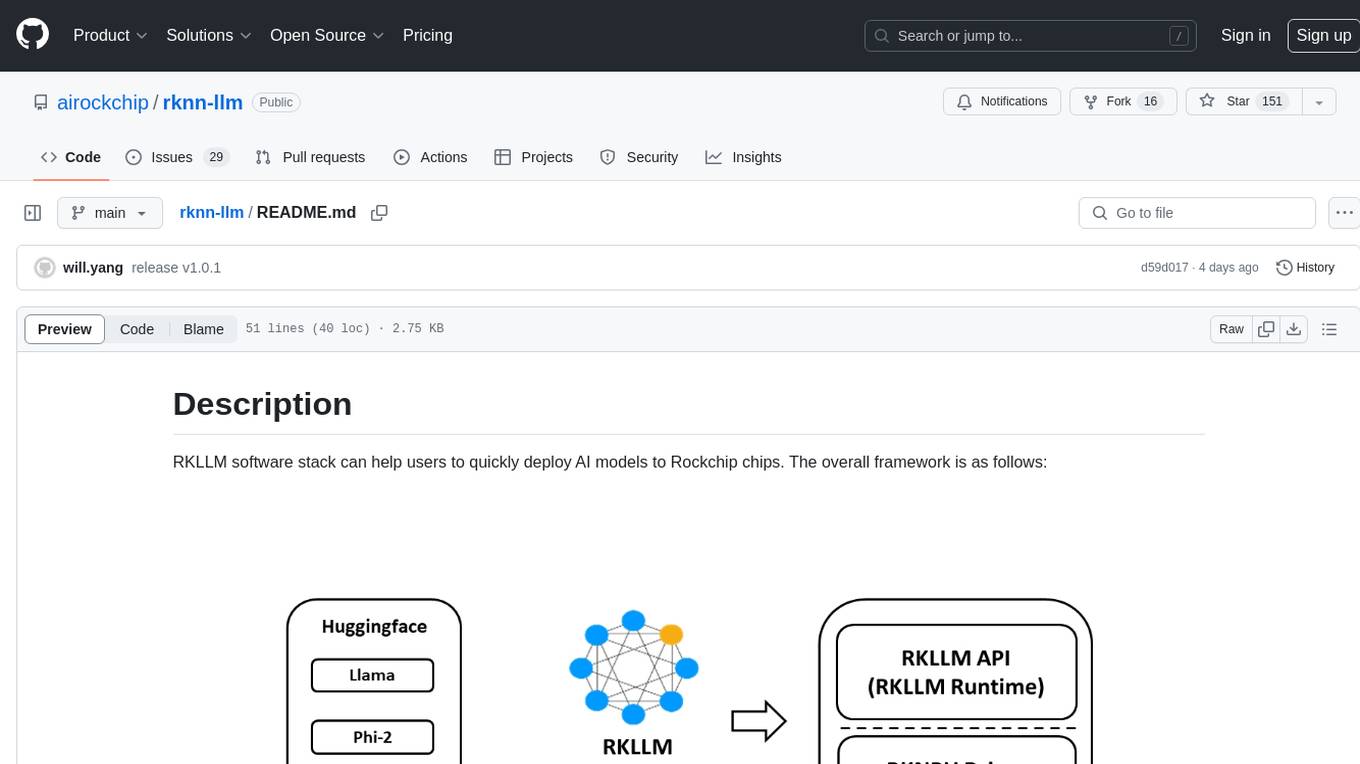
rknn-llm
RKLLM software stack is a toolkit designed to help users quickly deploy AI models to Rockchip chips. It consists of RKLLM-Toolkit for model conversion and quantization, RKLLM Runtime for deploying models on Rockchip NPU platform, and RKNPU kernel driver for hardware interaction. The toolkit supports RK3588 and RK3576 series chips and various models like TinyLLAMA, Qwen, Phi, ChatGLM3, Gemma, InternLM2, and MiniCPM. Users can download packages, docker images, examples, and docs from RKLLM_SDK. Additionally, RKNN-Toolkit2 SDK is available for deploying additional AI models.
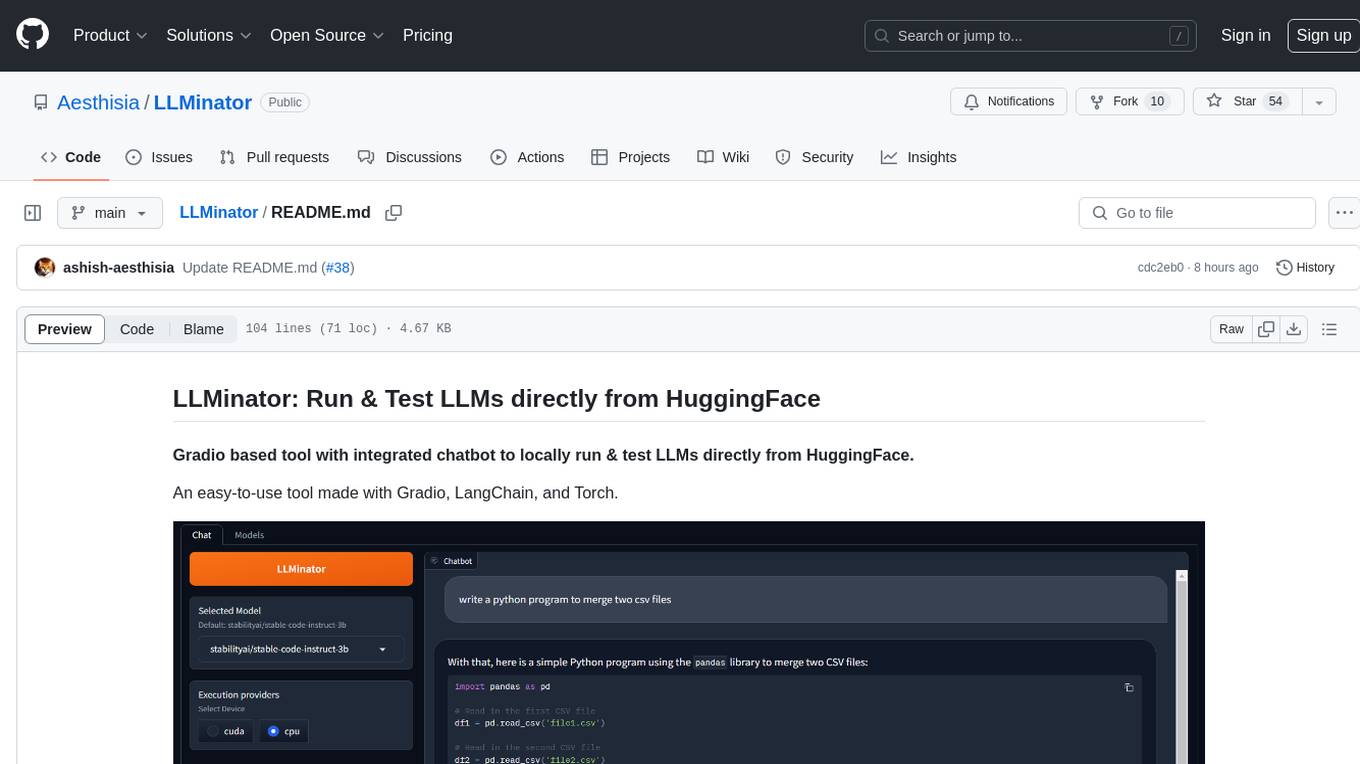
LLMinator
LLMinator is a Gradio-based tool with an integrated chatbot designed to locally run and test Language Model Models (LLMs) directly from HuggingFace. It provides an easy-to-use interface made with Gradio, LangChain, and Torch, offering features such as context-aware streaming chatbot, inbuilt code syntax highlighting, loading any LLM repo from HuggingFace, support for both CPU and CUDA modes, enabling LLM inference with llama.cpp, and model conversion capabilities.

xFasterTransformer
xFasterTransformer is an optimized solution for Large Language Models (LLMs) on the X86 platform, providing high performance and scalability for inference on mainstream LLM models. It offers C++ and Python APIs for easy integration, along with example codes and benchmark scripts. Users can prepare models in a different format, convert them, and use the APIs for tasks like encoding input prompts, generating token ids, and serving inference requests. The tool supports various data types and models, and can run in single or multi-rank modes using MPI. A web demo based on Gradio is available for popular LLM models like ChatGLM and Llama2. Benchmark scripts help evaluate model inference performance quickly, and MLServer enables serving with REST and gRPC interfaces.

ai-edge-torch
AI Edge Torch is a Python library that supports converting PyTorch models into a .tflite format for on-device applications on Android, iOS, and IoT devices. It offers broad CPU coverage with initial GPU and NPU support, closely integrating with PyTorch and providing good coverage of Core ATen operators. The library includes a PyTorch converter for model conversion and a Generative API for authoring mobile-optimized PyTorch Transformer models, enabling easy deployment of Large Language Models (LLMs) on mobile devices.
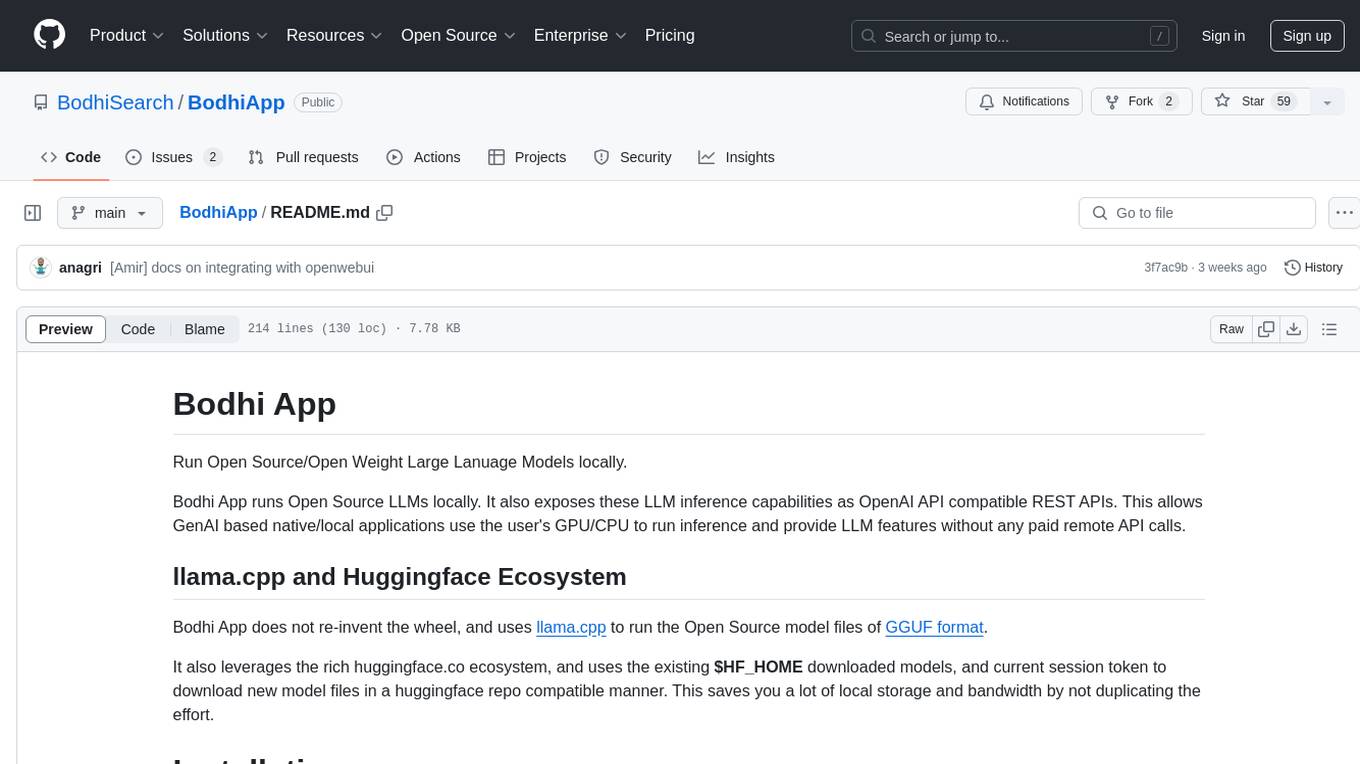
BodhiApp
Bodhi App runs Open Source Large Language Models locally, exposing LLM inference capabilities as OpenAI API compatible REST APIs. It leverages llama.cpp for GGUF format models and huggingface.co ecosystem for model downloads. Users can run fine-tuned models for chat completions, create custom aliases, and convert Huggingface models to GGUF format. The CLI offers commands for environment configuration, model management, pulling files, serving API, and more.
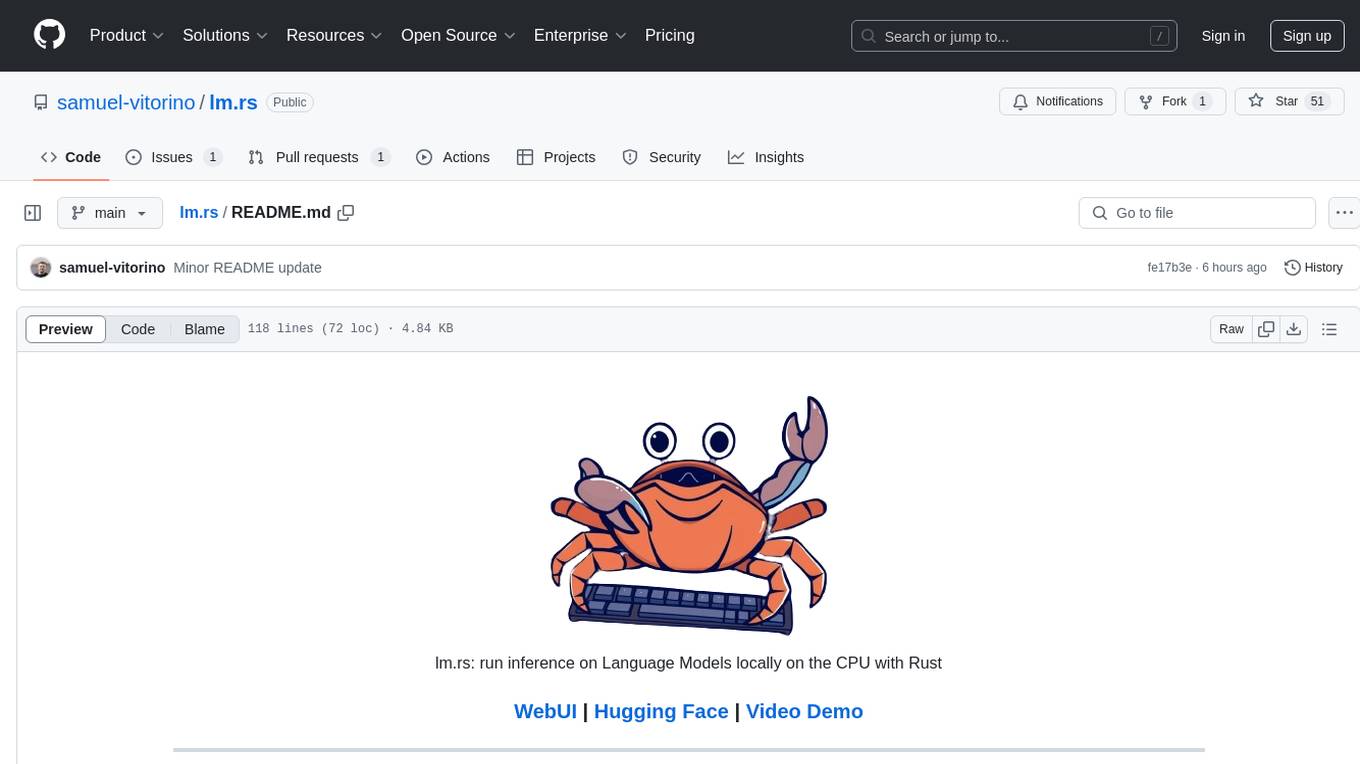
lm.rs
lm.rs is a tool that allows users to run inference on Language Models locally on the CPU using Rust. It supports LLama3.2 1B and 3B models, with a WebUI also available. The tool provides benchmarks and download links for models and tokenizers, with recommendations for quantization options. Users can convert models from Google/Meta on huggingface using provided scripts. The tool can be compiled with cargo and run with various arguments for model weights, tokenizer, temperature, and more. Additionally, a backend for the WebUI can be compiled and run to connect via the web interface.
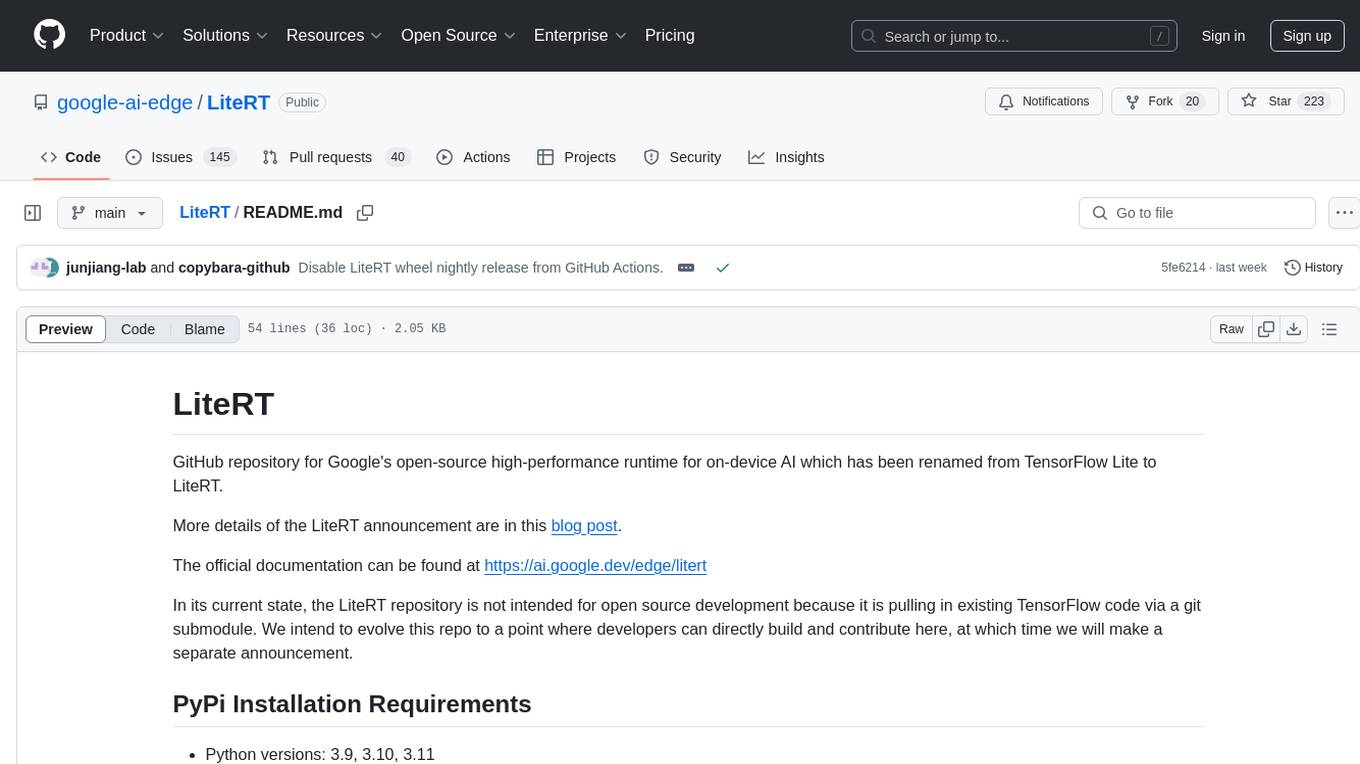
LiteRT
LiteRT is Google's open-source high-performance runtime for on-device AI, previously known as TensorFlow Lite. The repository is currently not intended for open-source development, but aims to evolve to allow direct building and contributions. LiteRT supports Python versions 3.9, 3.10, 3.11 on Linux and MacOS. It ensures compatibility with existing .tflite file extension and format, offering conversion tools and continued active development under the name LiteRT.
For similar jobs

sweep
Sweep is an AI junior developer that turns bugs and feature requests into code changes. It automatically handles developer experience improvements like adding type hints and improving test coverage.

teams-ai
The Teams AI Library is a software development kit (SDK) that helps developers create bots that can interact with Teams and Microsoft 365 applications. It is built on top of the Bot Framework SDK and simplifies the process of developing bots that interact with Teams' artificial intelligence capabilities. The SDK is available for JavaScript/TypeScript, .NET, and Python.

ai-guide
This guide is dedicated to Large Language Models (LLMs) that you can run on your home computer. It assumes your PC is a lower-end, non-gaming setup.

classifai
Supercharge WordPress Content Workflows and Engagement with Artificial Intelligence. Tap into leading cloud-based services like OpenAI, Microsoft Azure AI, Google Gemini and IBM Watson to augment your WordPress-powered websites. Publish content faster while improving SEO performance and increasing audience engagement. ClassifAI integrates Artificial Intelligence and Machine Learning technologies to lighten your workload and eliminate tedious tasks, giving you more time to create original content that matters.

chatbot-ui
Chatbot UI is an open-source AI chat app that allows users to create and deploy their own AI chatbots. It is easy to use and can be customized to fit any need. Chatbot UI is perfect for businesses, developers, and anyone who wants to create a chatbot.

BricksLLM
BricksLLM is a cloud native AI gateway written in Go. Currently, it provides native support for OpenAI, Anthropic, Azure OpenAI and vLLM. BricksLLM aims to provide enterprise level infrastructure that can power any LLM production use cases. Here are some use cases for BricksLLM: * Set LLM usage limits for users on different pricing tiers * Track LLM usage on a per user and per organization basis * Block or redact requests containing PIIs * Improve LLM reliability with failovers, retries and caching * Distribute API keys with rate limits and cost limits for internal development/production use cases * Distribute API keys with rate limits and cost limits for students

uAgents
uAgents is a Python library developed by Fetch.ai that allows for the creation of autonomous AI agents. These agents can perform various tasks on a schedule or take action on various events. uAgents are easy to create and manage, and they are connected to a fast-growing network of other uAgents. They are also secure, with cryptographically secured messages and wallets.

griptape
Griptape is a modular Python framework for building AI-powered applications that securely connect to your enterprise data and APIs. It offers developers the ability to maintain control and flexibility at every step. Griptape's core components include Structures (Agents, Pipelines, and Workflows), Tasks, Tools, Memory (Conversation Memory, Task Memory, and Meta Memory), Drivers (Prompt and Embedding Drivers, Vector Store Drivers, Image Generation Drivers, Image Query Drivers, SQL Drivers, Web Scraper Drivers, and Conversation Memory Drivers), Engines (Query Engines, Extraction Engines, Summary Engines, Image Generation Engines, and Image Query Engines), and additional components (Rulesets, Loaders, Artifacts, Chunkers, and Tokenizers). Griptape enables developers to create AI-powered applications with ease and efficiency.
